Over the last few months I’ve been data tracking the top 2025 NHL Draft eligible skaters in the CHL, USHL and NCAA. A few years ago I hand-tracked a handful of 2007-born Americans and it’s been interesting to see how they’ve developed now that they are all in Major Junior or the NCAA.
In this piece I’ll be covering the top 10 forwards in the dataset to this point who have the highest overalls according to the model and summative outcome. There are four main categories; scoring, playmaking, transition, and defense, that come to form the overall total.
A few things to note, all the data tracked is at 5v5 per-60-minute rate. A legend can be found at the end of this feature to help explain the numbers and what they mean.
10. Brady Martin | Center | Soo Greyhounds
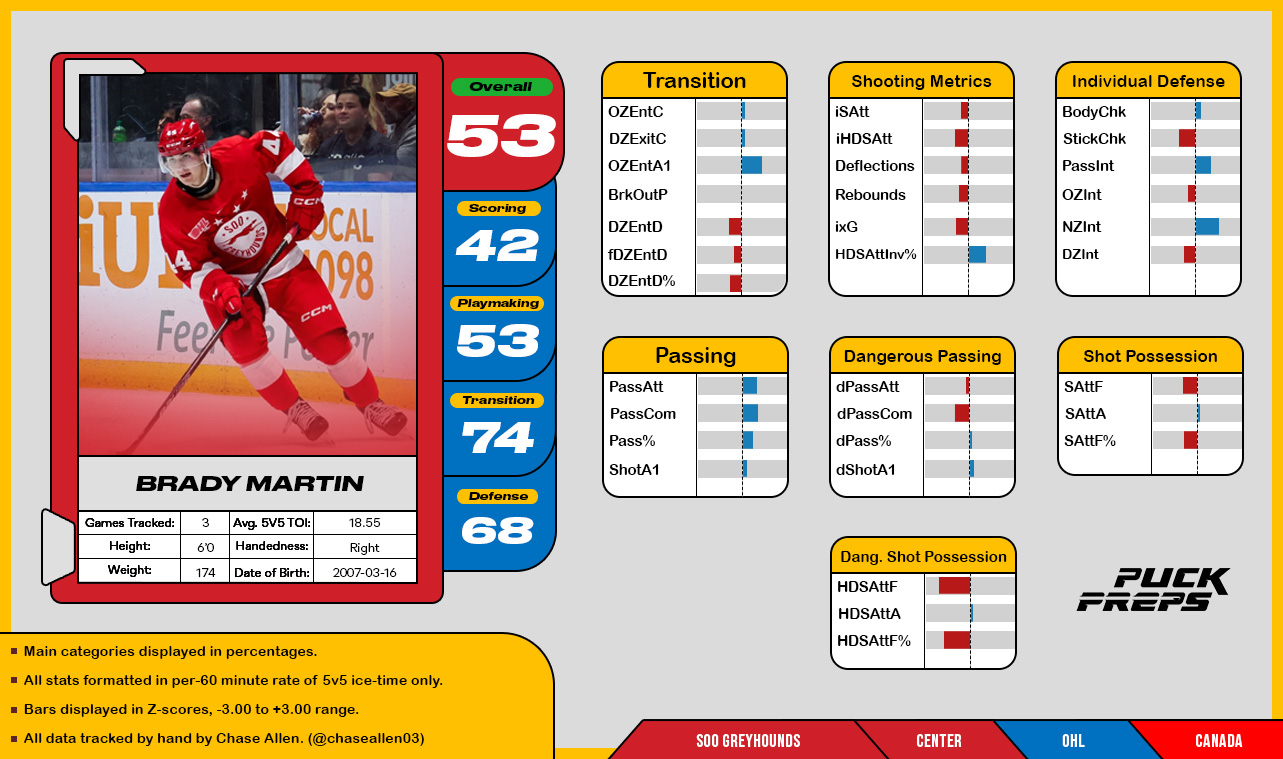
Smith has asserted himself as a fairly well-rounded player thus far into his NHL Draft campaign, being around average in all major categories. He’s been relied upon heavily by his team in the games tracked, averaging 18.55 5v5 minutes of ice time per game in the 3 games tracked. His tenacity and defensive acumen has made him a trustful player across all 3 zones, using physical play and strong anticipation to force turnovers, through bodychecks, along with intercepting pucks. His playmaking has been his greatest strength so far, being in the 53rd percentile amongst his peers, he has shown off the ability to both execute a simple pass, along with execute a flashy move 1-on-1 to create some space for himself towards the middle before setting up a teammate in a scoring situation. His ability to absorb contact made him effective at protecting pucks as he worked his way through crowds, enabling him to set up scoring chances in high danger areas. His transitional play ties into his playmaking game, he’s currently one of the leaders in OZEntA1, processing the game at a high level, he hit teammates with speed as the worked through the neutral zone, setting them up for success as they gained the line with control. Martin himself showed some good power to his stride carrying the puck, and once more, bouncing pucks off his teammates as he moved up ice, he would get everyone involved in the play with some quick puck movement through transition. The scoring element to his game has stalled behind slightly, mostly deferring to moving the puck instead of shooting, he has a shot that can threaten goalies at the OHL level, and has shown glimpses of being an effective goal scorer, but due to a stylistic means of play, won’t light the lamp as much as one would expect for a player who will flirt with going first round in the NHL Draft. Albeit he is one of the leaders in high danger shot attempt involvement, the Greyhounds have struggled to generate much high danger chances whilst he’s on the ice, but the ones they do get, he is directly responsible for contributing to either via a high danger shot of his own, or setting up a high danger shot. He’s definitely a player who projects well to the next level with his physical play, along with a display of intelligent decision making, the analytical numbers supporting his game is something that is more of a draw, making him more than just a big-bodied forward who plays a tough style of play.
9. Cameron Schmidt | Right Wing | Vancouver Giants
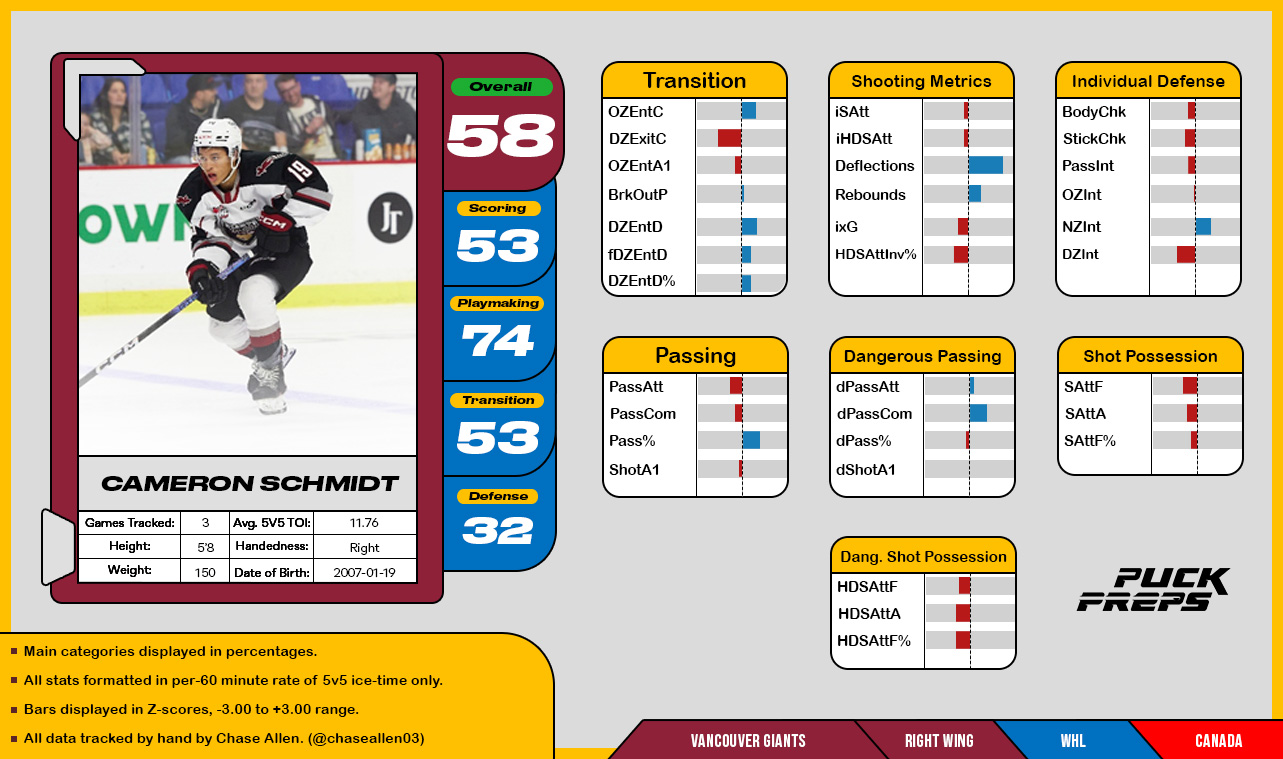
A favorite among many in this years’ NHL Draft class, Cameron Schmidt of the Vancouver Giants has produced some strong offensive metrics thus far in the tracking project. Despite his goal scoring prowess everyone is familiar with, he’s excelled in playmaking to this point, being incredibly accurate with his passes, both to dangerous areas, along with simpler passes. His puck handling dexterity and dynamism has allowed him to handle the puck in tight to his body, close to his feet, pull pucks through crowds and dance around sticks as he attempted to slip passes through traffic to the slot to generate quality scoring chances. With some excellent acceleration he’s been able to be one of the top transition threats in the dataset to this point. Heads-above average in offensive zone entries with control, he’s extremely tough to stop or slow down once he gets going. His processing, speed, and puck skills makes him one of the most effective puck carriers across the offensive blueline at the WHL level. He’s been below average in shot volume and quality in the games tracked, albeit considering his production this season, this may very well simply be as a result of the games tracked happening to be low-scoring games for Schmidt. For a smaller player he has found a way to succeed around the crease and away from the puck in the slot, getting sticks on incoming shots, along with being first on rebounds, he offers a strong level of compete in a smaller frame that is admirable. There are instances where he does get overpowered as he fights for space, or a 50-50 puck, strength gains will obviously be a need as he looks to develop into an NHL-level player, but the effort is certainly there, and given his skill and high-end ability, he’s a player several teams will be eyeing, potentially as early as the second-round. As the season continues and his sample size expands it can be expected to see his scoring metrics increase, getting greater exposure to his shooting talents in an array of games.
8. Malcolm Spence | Left Wing | Erie Otters
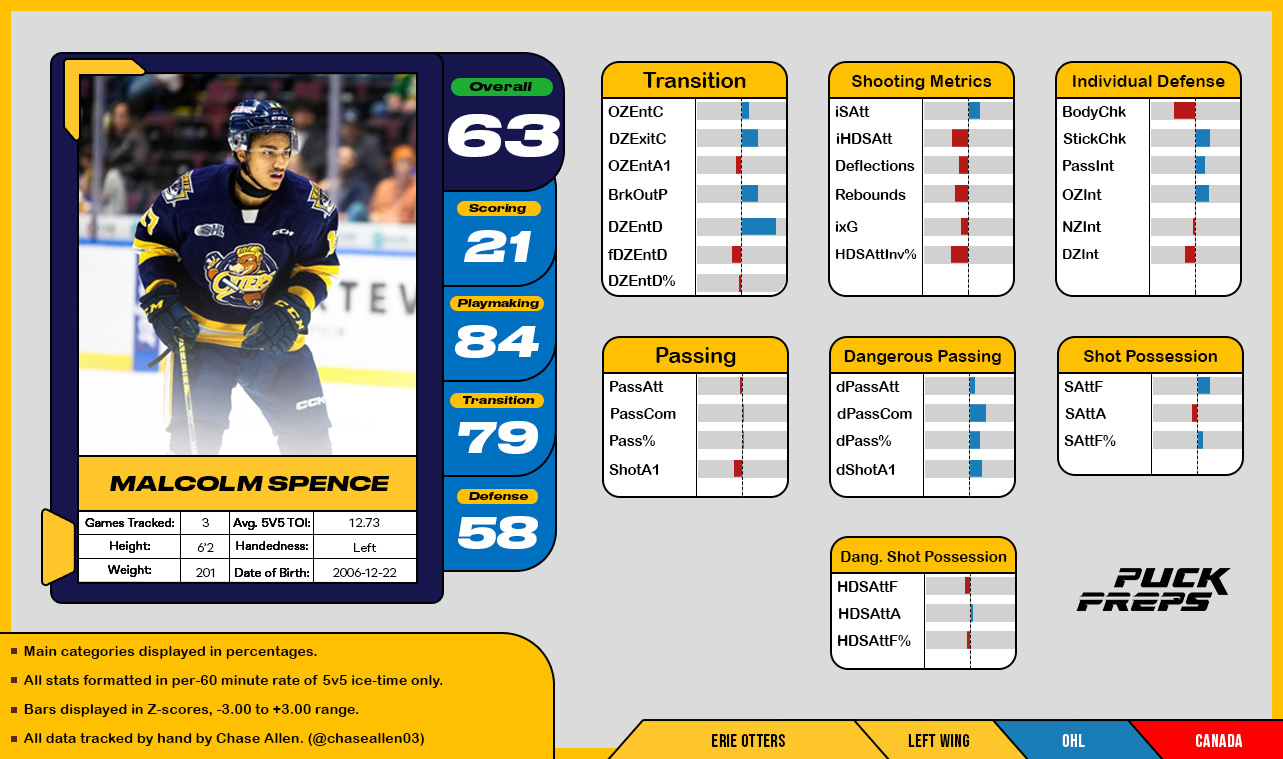
Malcolm Spence has great size and power, which is the primary driver of his play. His athletic build enables him to traverse the ice and create space by working through contact and connecting plays tight to the net and in the slot. He’s shown a great ability thus far to keep pucks alive towards the outside of the offensive zone, spinning off checkers, making a play with a defender on his shoulder, and occasionally finding the space to pull off a flashy move to create some more ice for himself to get around his man. Thanks to his shiftiness and strength he’s found ways to be one of the best playmakers from below the goal line, setting up plenty of high-quality chances which can be seen across all of his dangerous passing metrics. He lands in the 84th percentile of playmaking and completes dangerous passes more than just about anyone in the dataset. Mirroring his playmaking ability, his transition game goes hand-in-hand with his offensive prowess, effective off the rush, and with such great range and control of the puck he has been able to string together passing plays with speed as his team works their way up ice. His scoring has lagged behind a little in regards to his playmaking, the majority of his shot attempts are coming from low-danger, outside areas of the offensive zone, and there aren’t many opportunities where Spence will drive the slot himself and take a shot of his own. To further bolster his game, he’s shown to be a strong forechecking piece, who has been able to land stick checks and strip opponents of the puck deep in the offensive zone. His long stride and size really helps close-in on puck carriers, taking away their time and space. Spence has certainly made himself one of the more intriguing prospects eligible for the 2025 NHL Draft, the size, speed, and compete that he’s shown early on is something that many NHL teams will be interested in. Currently listed as a definite first round pick by many, even flirting with the top 10 in some rankings, the deeper numbers to his game certainly help strengthen that argument.
7. Emile Guite | Left Wing | Chicoutimi Sagueneens
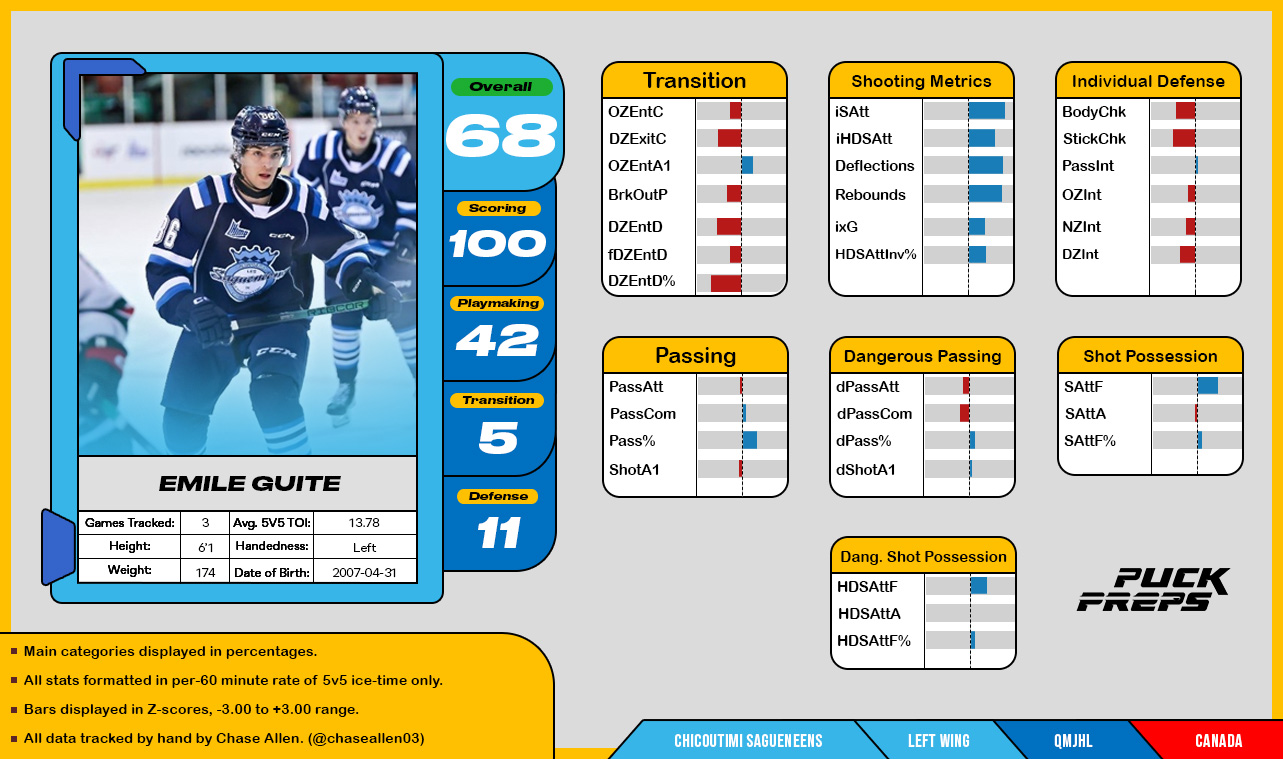
It’s fairly obvious what Emile Guite brings to the table; scoring, scoring, and scoring. Perhaps one of the best scoring threats within the entire draft, the combination of size and a willingness to go to the dirty areas to find success on top of his talent has made him one of the best goal scorers in the data set to this point. He’s shown great awareness off-puck, getting lost in coverage and popping up at just the right time to catch a pass and wire it on net with power and precision. Both his wrister and his one-timer are well developed for his age, and his 6’1, 174lb frame does him wonders in regards to overpowering opposition fighting for ice along with boxing out opponents when he does have the puck in these dangerous areas of the game. He’s shown some delicate skill and puck touches in tight, but nothing too significant to lead to a multitude of high danger chances for his linemates. At times a lack of processing and creativity can allow defenders to stifle him in tight, limiting his ability to set teammates up for quality looks. Albeit, when he is able to get these passes off, he does find success, the biggest issue is more so the volume of when and how often these passes are attempted. It’ll be interesting to see how he diversifies his offensive game as he moves up levels in hockey, as we know his scoring touch is lethal, but at what point will he need to add more weapons to his arsenal? In transition we haven’t seen too much in terms of carrying the puck with speed, he has a strong forward stride, but at times getting going and making those delicate cuts and pivots can be a challenge. That being said, he has shown an above-average ability to hit teammates with passes to set them up for zone entries. An argument to show that he processes the game better than his playmaking may suggest. Away from the puck he hasn’t shown to be too influential, intercepting a pass here-and-there, his wingspan allows him to reach and pick off pucks, but at times you’re left wanting a bit more usage out of the physical frame, competing for pucks. Players like Guite are in every draft, uber-talented goal scorers who love to shoot, often coming with some degree of risk to their game, the production hasn’t quite been there like it was in his DY-1 season, so it’ll be extremely interesting to see where a player like Guite lands in the draft.
6. Cullen Potter | Center | Arizona State University

Cullen Potter is one of the most exciting players eligible for this years’ draft, offering lethal speed, and being one of two 2007’s to play in the NCAA this season, he’s transitioned nicely to the next level with Arizona State University, and has some strong advanced numbers to support him. From a young age Potter has always brought tremendous energy and pace to the game, making him an elite offensive threat, and although he is still strong offensively, systems have tightened up, and the scoring has dropped somewhat. Despite that, his defensive involvement thanks to his speed still has him as one of the most frustrating opponents to play against. He is heavily involved in retrievals and on the forecheck, closing gaps with speed and executing incredibly smooth stick checks to strip opponents of possession. Despite the lack of considerable size, he is still one to lay the body and play physical further diversifying his method of forcing turnovers. Seen to be strong across all 3 zones in intercepting pucks and forcing turnovers, Potter is one of the best 200-foot players in the class. Moving onto some of the more exciting areas of his game, he continues to be one of the top transition threats. His speed is incredible, matched with lightning quick hands, he can make a fool of a defender 1-on-1, opening up some space to the middle for dangerous looks. One of the main criticisms of Potter throughout his development was that of at times overlooking options and being a little too narrow-minded with the puck. By no means is it an act of selfishness, more so a lack of awareness of his options, at times overcomplicating things and leading to a needless turnover when a simpler play was available. He’s certainly shown flashes of being an effective scorer at the NCAA level to this point, a high-volume shooter to this point, he has a lethal release in motion that complements his speed and transition game very well. At times you’d wish he’d find ways to get his shot off a little closer to the net and or the slot area, but that adaptation to the NCAA is something you cannot overlook, playing bigger, and older opponents, also whilst playing college level hockey a year earlier than he was “supposed” to. Looking forward to the NHL Draft, players of Potters’ build don’t always get selected as early as their skill would indicate, leaving room for a team to get an absolute value pick in this feisty, speedy, two-way forward.
5. Benjamin Kevan | Left Wing | Des Moines Buccaneers
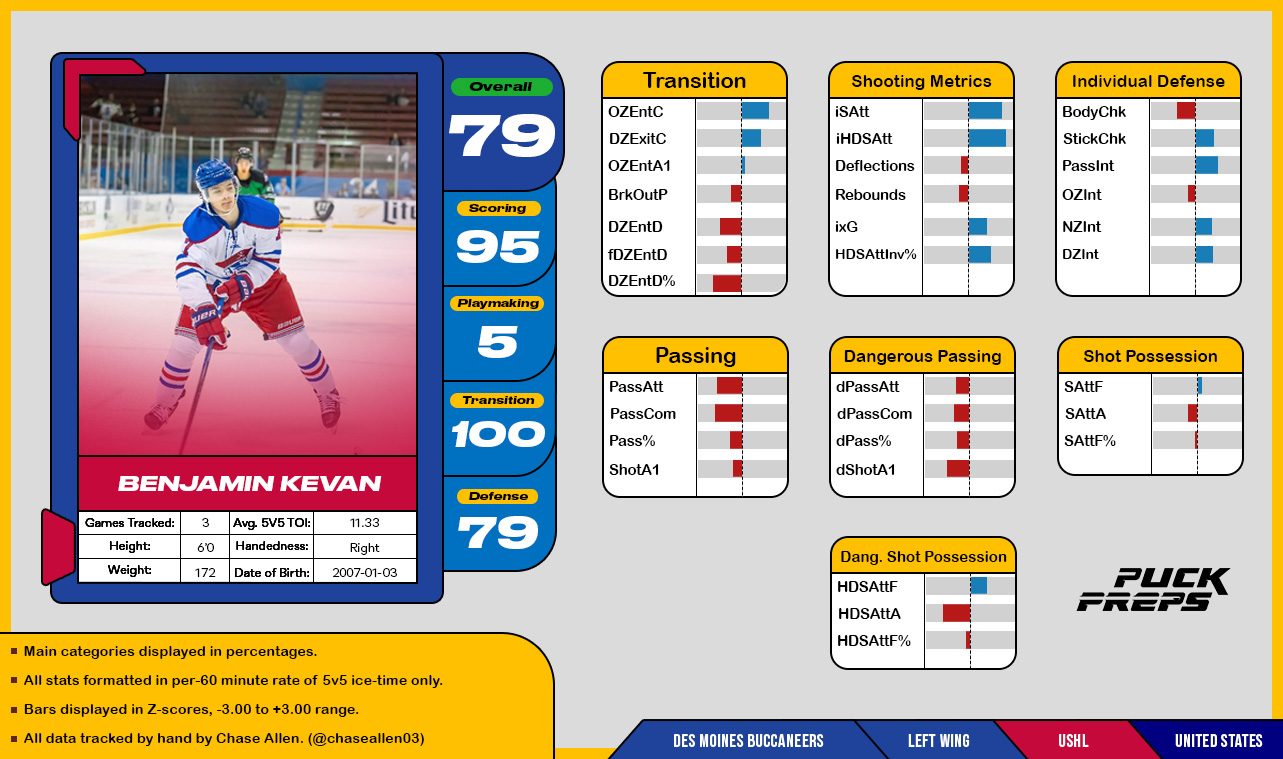
Perhaps a surprise to some to see Benjamin Kevan this highly rated, especially considering some of the names he is ahead of, but even going back to his play in his USHL draft season with the Los Angeles Jr. Kings, he has always produced strong advanced numbers, demonstrating a competitive game on the defensive side of the puck, combined with some sound scoring ability. He’s one of the best players in the database at landing stick checks and body checks, hounding puck carriers and never giving up on a play. It can be tough to properly articulate effort through analytics, but it can be seen he is effective at denying chances, intercepting pucks, and being engaged away from it. He won’t necessarily “wow” with elite scoring tools, but he plays a simple game, has good athleticism to get him into spots, carving out some space for himself, he can finish plays, and if needed make deft moves in tight to opponents and goaltenders to add some dynamism to his play. Something that has always helped Kevan as he’s gone up in the levels of hockey has been his effort, and ability to play a role. Moving to major-junior he wasn’t the same offensive stud he was in AAA, but he was able to find ice, get to where he needed to be, play a strong team game, and do what he needed to do on the defensive side of things to help his team. He’s listed as the top transition player to this point in the data – another surprise considering some of the players he’s being stacked up against. But once more, he plays a simple game and with good power and puck handling has been able to find routes, avoid traffic, and if needed, make a quick adjustment around an obstacle. The playmaking has stalled behind a little bit, there isn’t much to his game regarding attempting high-end passes, as mentioned, he mostly will opt for the simple play, and then proceed to go to the net to get a chance of his own. Granted, I don’t see this as too much of a problem considering his ability to be a chameleon and embrace wherever you put him, he provides plenty of value elsewhere as we can see. Currently listed as a second rounder by many, NHL teams will love the versatility he provides. Committed to Arizona State University, he will be another strong 07’ addition to their roster alongside Cullen Potter come next season.
4. Michael Misa | Center | Saginaw Spirit
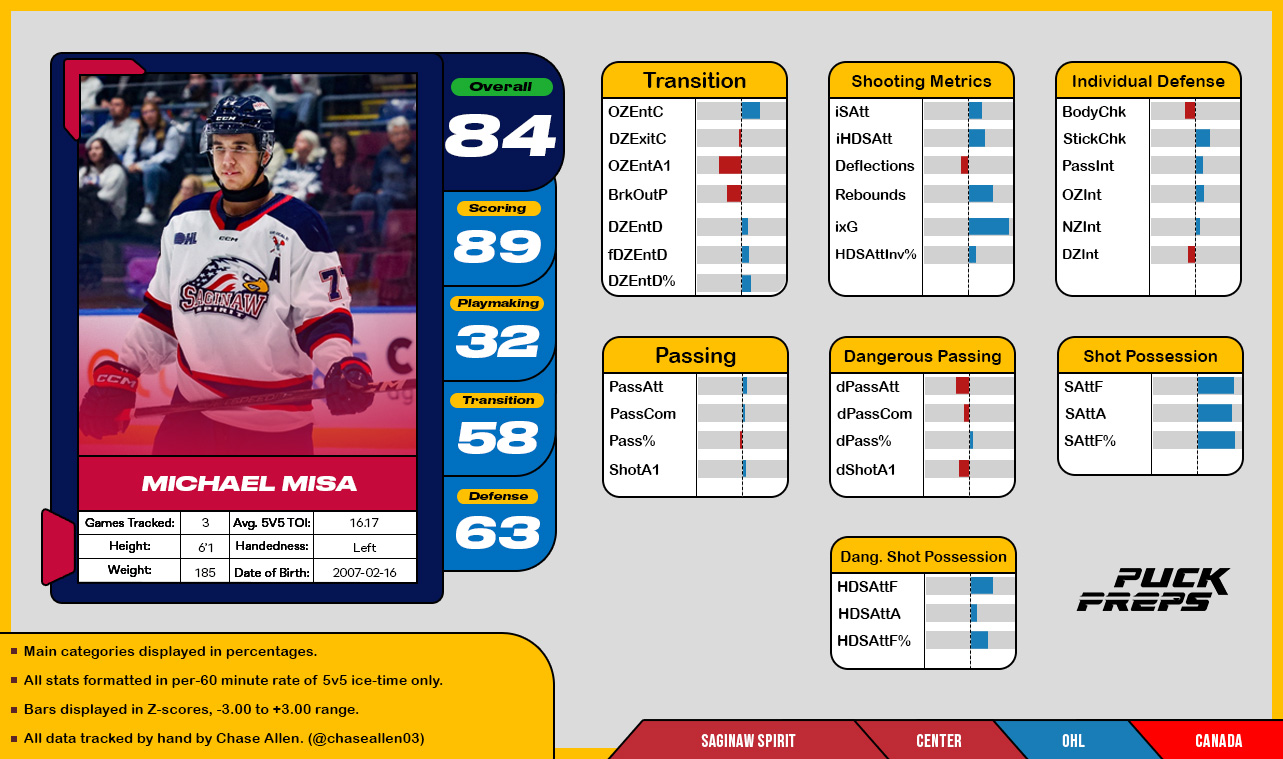
With his torrid start to the season, Michael Misa only continues to justify himself as top 5 pick in the 2025 NHL Draft as the season goes on, backing it up with some strong advanced numbers. He is by far one of the most intelligent and skilled players in the draft. His ability to corral and settle bouncing and awkward pucks and quickly identify an option and make a play really helps him drive play. He attempts plenty of regular passes, along with completes many, although the passing percentage lags behind some who are lower-volume passers. Despite this, the opposite is the case for his dangerous passing. He’s very opportunistic, rarely attempting dangerous passes, but when he does, he finds a way to complete them. His ability to set up shots through his ShotA1 (shot assists) is one of the main reasons that when Misa is on the ice, he is overwhelmingly positive in the shot attempt differential. One of the reasons he’s been so dominant in the OHL to this point in the season is thanks to his scoring ability. He has done an excellent job so far at taking pucks to the slot, dangling around a series of bodies and ripping a shot on net with excellent accuracy. He’s really taken that step to be more aggressive with the puck as he drives the slot and middle lane, staying strong on his feet, and getting chances in tight to the net. The leader in individual expected goals, he routinely gets plenty of quality shot attempts each game. He’s worked well his teammates to move the puck, creating space, and once again getting lost in coverage as he sifts into open ice around the net, backdoor or around the hashmarks. His scoring touch has been a nice balance of chances he’s created himself through some elite skill, along with being the beneficiary of a nice pass from a teammate, showing the versatility in his scoring ability. Misa has shown off some strong defensive metrics thus far to round things out, something many NHL teams will look for in a hopeful, first line NHL center. He reads play well, can jump into lane to pick off passes, but has an incredibly delicate series of stick checks to strip opponents of the puck and quickly move up ice on the counter. As of now, Misa has forced himself into some discussions as the first overall pick in this years’ draft.
3. Carter Bear | Left Wing | Everett Silvertips
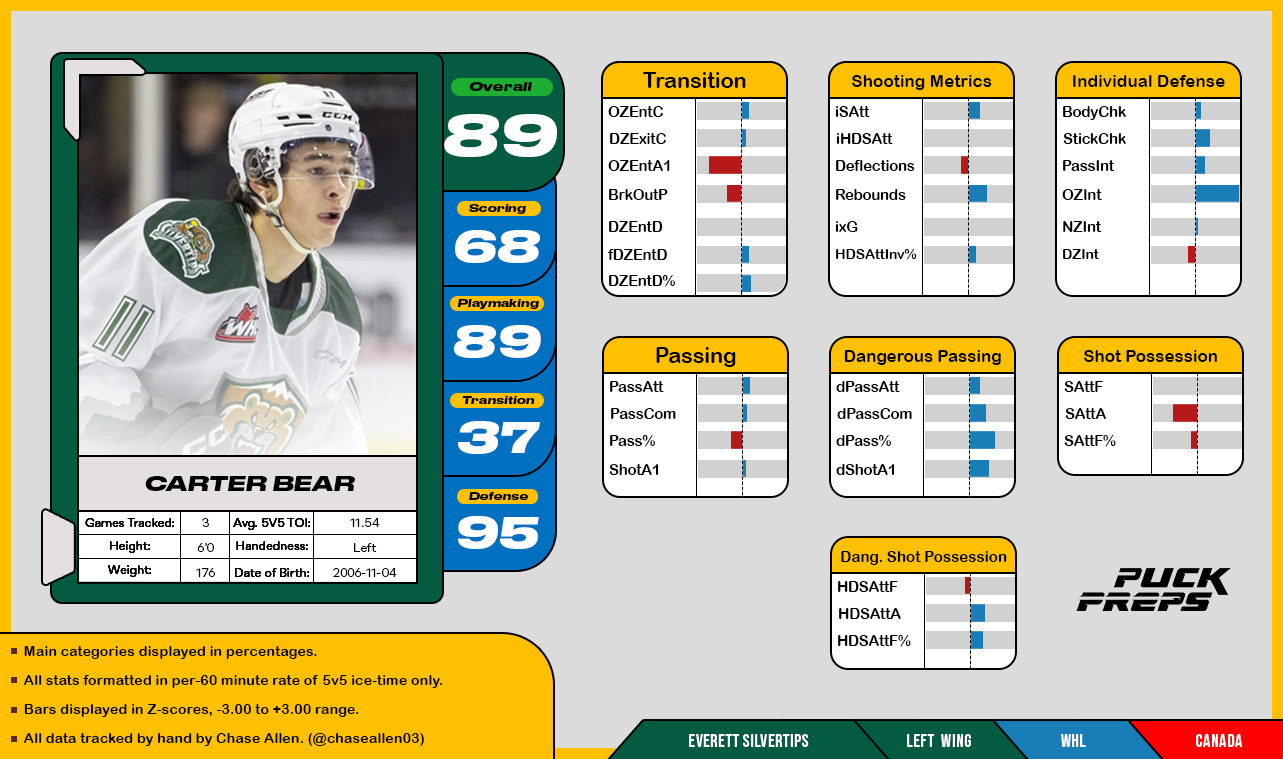
Carter Bear has been one the quickest risers amongst the NHL Draft community this season, being seen through his recent promotion to an A-rated prospect on NHL Central Scouting, the numbers have also been there to support this move. Beyond his tremendous production in the WHL, it’s the style of play that offers him great projectability. He has a motor that never turns off, an absolute pain to play against, he’s been tremendous on the forecheck at winning pucks and quickly being able to make something of it. By any means necessary will he force a puck free, using either the stick or the body, he is incredibly efficient in scrums and upon leaving them can pull off some slippery moves to create some space for himself, ensuring himself, and the puck, doesn’t get pinned back into a battle or scrum. He’s shown to be effective at forcing neutral zone turnovers, taking good routes to opponents, and quickly hoping on loose pucks, he’s been able to string together some quick rushes through the neutral zone, into the offensive zone, on the offensive counterattack. Again, on top of this motor and high effort level, he owns some great skill of his own and has been able to navigate the ice with quick adaptations to the puck as he makes powerful pivots and cuts on his edges. His tenacity and urgency has made him an effective scoring piece to complement everything else he offers. Quick to get on rebound chances, along with shooting in volume, he doesn’t always get the greatest looks for himself, but due to finding the space to pepper the goaltender, he is above average regarding scoring in the data set, sitting in the 68th percentile. His playmaking has been the highlight to his game thus far, demonstrating excellent puck skills and vision, his hands and passing accuracy, along with timing has him as one of the most dangerous playmakers in the class. His deployment at 5v5 has been somewhat limited, averaging just around 11 minutes of 5v5 ice time in the games tracked, but to this point he has made the absolute most of his ice time. He’s certainly another player who brings that effort and energy to the table, and also has the numbers to back it up.
2. Porter Martone | Right Wing | Brampton Steelheads
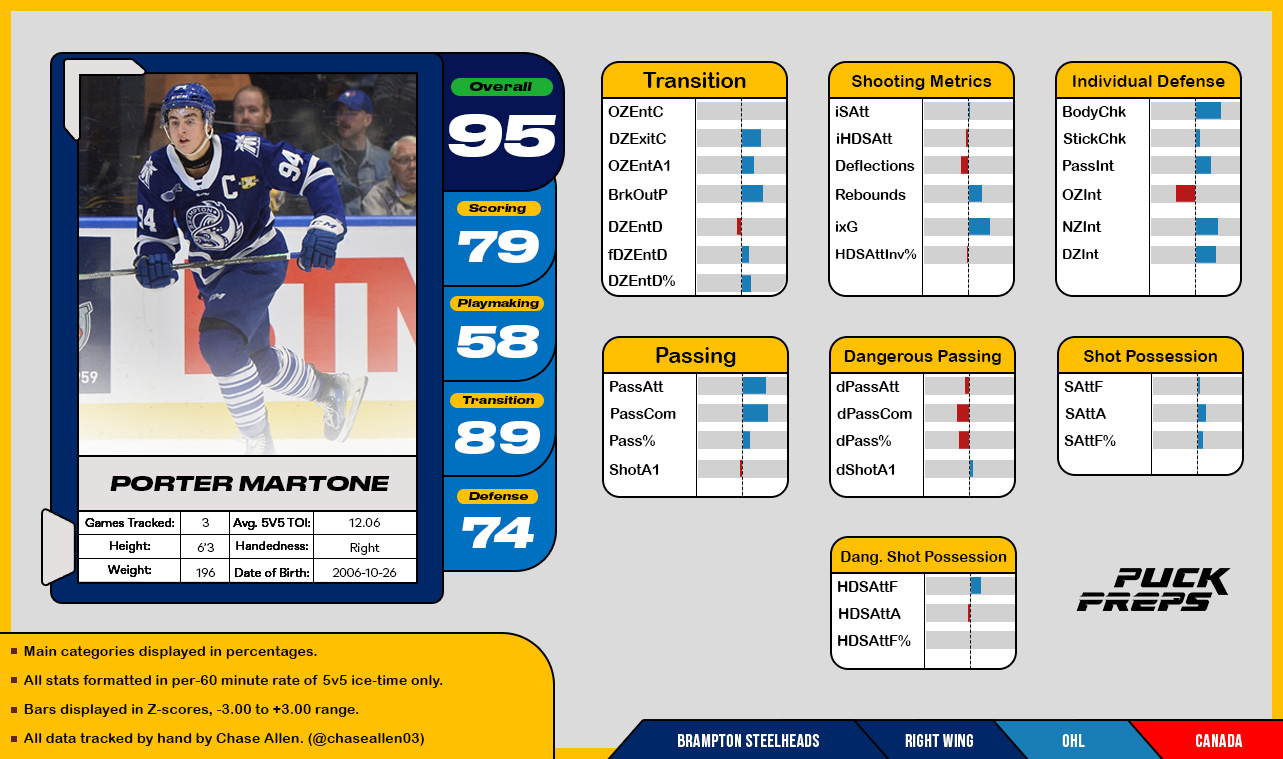
Porter Martone is another OHLer that has been on fire to start the OHL campaign. The 6’3 and 198lb frame combined with elite skill and elite scoring ability has made him one of the most effective players out there. He boxes out opponents around the net very well to win space, get on pucks, and fire rebounds on net. He can corral bouncing pucks quickly to settle them in effort to get a shot on net through traffic making him effective in difficult situations. His ixG and iHDSatt don’t perfectly line up – certainly a discrepancy between how I view high danger shot attempts and how expected goals are tallied, but regardless, he gets enough looks, and good enough looks to be one of the leaders in expected goals. His release is dynamite, capable of curling pucks and changing up the release angle as he makes his way up ice off the rush, he can be very tough to contain once he has speed and momentum backing him. He’s strong in every metric regarding transition that are relevant to forwards asides from gaining the line with control for himself, at times a lack of footspeed can cause defenders to close him off, although that may be the case, he has shown the ability to shoot off passes and hit speedier teammates in transition to assist them in gaining the zone. There are instances of strong transition ability when carrying the puck, out of the defensive zone he certainly does a good job holding off opponents and clearing pucks with control and has been seen to carry his momentum up the ice into the offensive zone using the same tricks, size, range, quick hands, but not at a consistent level. He’s been a dogged off-puck player and has contributed well from inside his defensive zone. Using the body to no surprise to force opponents off pucks and bring cycle chances to a halt. He’s tough to contend with on 50/50 pucks, both using size and leverage to overpower and then proceeding to box out opponents. Martone is another representative from the OHL who will go high in the 2025 NHL Draft, and in some circles, has been viewed as a candidate for first overall.
1. James Hagens | Center | Boston College
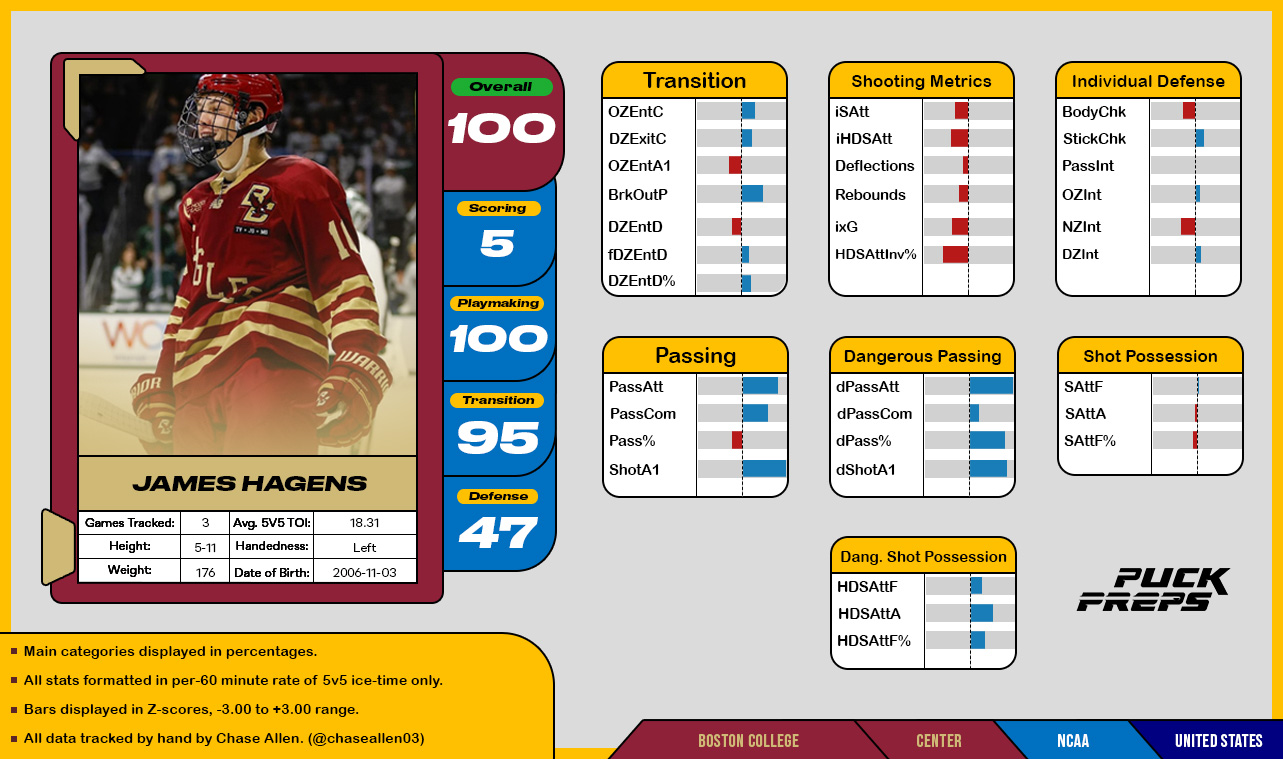
It’s not always the data lines up with general consensus on top players, but to see James Hagens rated as the highest overall forward lines up nicely with the many who have him pegged at first overall for the 2025 NHL Draft. He is heads-and-away above the rest regarding his playmaking abilities. He drives play with plenty of pass attempts, having dozens upon dozens of puck touches in any given game, he is seemingly always open, and always can wiggle his way around from pressure to give him time and space to make a play. He’s been shown to be one of the top players in the database to this point at elevating his teammates, seen through his shot assist metric, along with dangerous shot assists. He has nearly perfected the art of executing both the simple play to keep play alive, spread around the love, along with execute those dazzling, high-end pass attempts that lead to highlight reel goals. It is incredibly rare you see Hagens make an egregious error with the puck, always calm, cool, and controlled. In transition his evasive nature and strong base of skating abilities makes him tough to slow down and contain, he’s had no issues adjusting to the pace at the NCAA level, and frankly, has been one of the top players in the games tracked at carrying the puck and elevating the pace of play by challenging the middle, even commanding it at times with bold inside moves in stride. Defensively he’s played a great 200-foot game, in his own end he mans his assignments well, shadows puck carriers with great detail and is always aware of potential backdoor or centering efforts. His intelligence and timely nature rubs off in both the offensive zone and defensive zone, along with when working his way through the neutral zone as he processes his options. Scoring at the NCAA has certainly been a struggle to this point, this is apparent on both the box score and the deeper numbers, although, not for a lack of ability, more so a stylistic play. He’s been leaning heavily to moving the puck and making plays early in the season, and you would definitely like to see greater production, but the adaptation to less time-and-space between the dots and in those prime scoring locations has been something for Hagens to get used to. We know the shot he owns; he has shown his quick release and ability to get it off here-and-there, but nothing quite to the degree you may have expected. Regardless, his intelligence in seemingly any situation has made him one of the most coveted players from this 2006-born age group for awhile now, and by nearly every draft book out there, he is pegged as the first overall pick for the draft. Likely, one of the most pro-ready players eligible.
List of players tracked not in the Top 10:
Cole Reschny, Roger McQueen, John Mooney, Caleb Desnoyers, Tanner Lam, William Belle, Conrad Fondrk, Jake O’Brien, Gavin Cornforth, Liam Kilfoil.
Legend:
OZEntC/DZExitC: Offensive/Defensive zone entries/exits with control.
OZEntA1: Primary assist on a zone entry of a teammate (i.e., setting up a controlled zone entry)
DZEntD/fDZEntD: Defensive zone entry denials, failed defensive zone entry denials (a giving up of the defensive zone blueline)
PassAtt/PassCom/dPassAtt/dPassCom: Passes attempted, passes completed, along with dangerous passing metrics. Dangerous referring to passes going through-or-to the homeplate/slot region of the offensive zone.
dShotA1: Dangerous shot attempt assists.
iSAtt/iHDSAtt: Individual shot attempts and high danger shot attempts coming from the individual player.
HDSAttInv%: The percentage of high danger shot attempts the player is involved in for their team.
NZInt/OZInt/DZInt: Neutral, Offensive, and Defensive zone interceptions/forced turnovers.